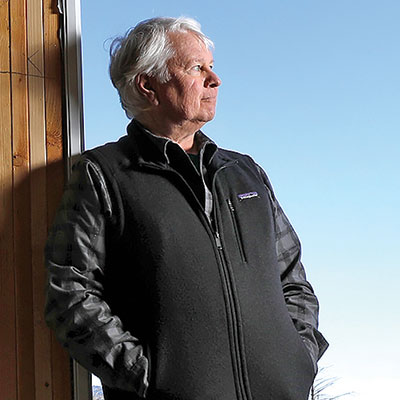Planning April 2019
Viewpoint
Fire Changes Everything
By Pete Parkinson, AICP
Shortly after midnight on October 9, 2017, I woke to something no one living in the wildland-urban interface wants to see. Near hurricane-force winds were whipping around multiple fires that eventually killed 44 people and destroyed more than 6,000 homes an hour north of San Francisco. My home and most of my neighborhood was lost.

Pete Parkinson, AICP, is the immediate past president of the California Chapter of APA. He has more than 35 years of professional planning experience, including as the planning director of Sonoma County, California. He and his family hope to move into their rebuilt (and much safer) home this summer. Photo courtesy Press-Democrat.
As catastrophic as this was, our disaster was eclipsed by the Camp Fire in Northern California, which killed 86 people and destroyed more than 14,000 homes last November. The two most destructive fires in California history occurred only 13 months apart.
These firestorms fundamentally changed my thinking about life and land-use planning in the WUI. As a planning director and planner in three California counties over the past 35 years, I believe we need to rethink our approach to wildfire hazard mitigation and development in fire-prone areas.
For decades, the unspoken assumption has been: "Go ahead and build in fire hazard areas; we can protect you." Communities have focused fire protection methods on access, water supply, structural hardening under WUI building standards, and defensible space. Even today, projects that increase density in fire-prone areas continue to be approved, relying on evacuation plans and "shelter in place" strategies to protect future residents.
But how do these efforts look through the lens of California's recent firestorms?
Evacuation plans are essential, but firestorms that consume a football field-sized area every second do not unfold according to plan. Last November, residents fleeing Paradise were overtaken by fire, and some died in their vehicles. The speed, intensity, and scope of the firestorms created an exodus that completely overwhelmed evacuation routes.
Similarly, sheltering in place is a last-resort strategy, not a plan. The WUI standards for new buildings increase the odds of a building surviving a wildfire, but relying on hardened structures to protect an entire community is the definition of hubris. While homes built to WUI standards are safer, they are not fireproof.
Defensible space reduces flammable vegetation around homes and is critical to protecting property in fire-prone areas, but only if it is maintained over the long term — and only if individual owners remain diligent, which means it's generally less effective on a community-wide scale.
These methods are no longer enough in our climate change-driven "new normal." We plan for what we can envision, but our vision has been insufficient. As planners and local government decision makers, we thought we adequately understood the hazards and planned accordingly. We were wrong. As emergency responders, we trained and exercised for scenarios we thought were the "worst case." We were wrong about that, too.
We must change our approach. We now know that increased density in rural, fire-prone areas only increases the likelihood of a catastrophic fire. Yes, hazard mitigation and fire-safe standards help, but they do not offset the risk. We need to stop adding more fuel to the natural landscape and come to grips with the fact that the potential for catastrophic fire in some areas is too high to allow additional residential development.
Planners can help in existing developed areas, too. We can develop community-wide and long-term strategies for vegetation management that are less reliant on the actions of individual owners. And in some communities, planners can develop retrofit strategies to harden existing structures and improve evacuation routes.
These fires exceeded our planning and imagination. We've received an object lesson in the risks of putting people in harm's way — a lesson that must inform our general plans and everyday planning practice.
Viewpoint is Planning's op-ed column. The views expressed here are the author's own and do not necessarily reflect those of the magazine or the American Planning Association. Please send column ideas to Lindsay R. Nieman, Planning's associate editor, at lnieman@planning.org.


